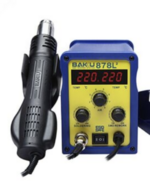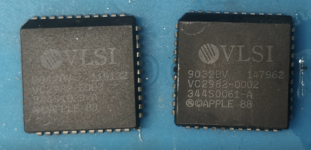ironborn65
Well-known member
Dear mates,
I had a non-backlit Mac Portable on the shelf for a year. It was given to me by a guy who sent it to a lab for recapping, but went out of business before finishing the job.
I had a complete set with a battery and charger.
The MB had no sign of leaking, very clean and nice.
The MB was without caps and some were electrolytic instead of the SMD, so I replaced them all with the proper ones (not the tantalum ones).
They removed the SWIM which was attached with a tape to the external PSU, I do not know why and if it's working, The pads were clean and not corroded.
I soldered a 44-pins socket taking care of the right orientation and I inserted the SWIM.
I did my homework and I studies the power supply system in the Apple tech manual.
I then inserted a new 6.5V 1.5A lead battery in the internal battery case, it tested 6.45V, and the external PSU was 7.5V (it was corrected after initially writing 9V).
I pressed the microswitch and I heard a croaking noise and I had a weird pattern on the LCD screen.
I decided to remove the SWIM (I'm glad I used a socket) and hurray, it played the happy chime BONG.
I don't know if the SWIM is bad (it'd explain why it was removed) or if my tiny SMD skills are not good enough.
Now I have these symptoms:
the screen remains "black", it's on, but no smiley face
the reset does work, BONG, but it stops again
the interrupt switch brings a sad mac with code 03001300 / 00001FFA, the sad mac code guide says that pressing the interrupt while in boot mode brings the sad mac, so I assume the Mac is trying to boot.
pressing both reset and the interrupt brings the sad mac
the yellow led on the scsi2sd plugged in the back does not blink, it does in my other macs when I turn them on, before actually booting the OS
now, the question is
I believe the boot sequence stops because the SWIM is not present? is it?
I had a non-backlit Mac Portable on the shelf for a year. It was given to me by a guy who sent it to a lab for recapping, but went out of business before finishing the job.
I had a complete set with a battery and charger.
The MB had no sign of leaking, very clean and nice.
The MB was without caps and some were electrolytic instead of the SMD, so I replaced them all with the proper ones (not the tantalum ones).
They removed the SWIM which was attached with a tape to the external PSU, I do not know why and if it's working, The pads were clean and not corroded.
I soldered a 44-pins socket taking care of the right orientation and I inserted the SWIM.
I did my homework and I studies the power supply system in the Apple tech manual.
I then inserted a new 6.5V 1.5A lead battery in the internal battery case, it tested 6.45V, and the external PSU was 7.5V (it was corrected after initially writing 9V).
I pressed the microswitch and I heard a croaking noise and I had a weird pattern on the LCD screen.
I decided to remove the SWIM (I'm glad I used a socket) and hurray, it played the happy chime BONG.
I don't know if the SWIM is bad (it'd explain why it was removed) or if my tiny SMD skills are not good enough.
Now I have these symptoms:
the screen remains "black", it's on, but no smiley face
the reset does work, BONG, but it stops again
the interrupt switch brings a sad mac with code 03001300 / 00001FFA, the sad mac code guide says that pressing the interrupt while in boot mode brings the sad mac, so I assume the Mac is trying to boot.
pressing both reset and the interrupt brings the sad mac
the yellow led on the scsi2sd plugged in the back does not blink, it does in my other macs when I turn them on, before actually booting the OS
now, the question is
I believe the boot sequence stops because the SWIM is not present? is it?
Last edited:



